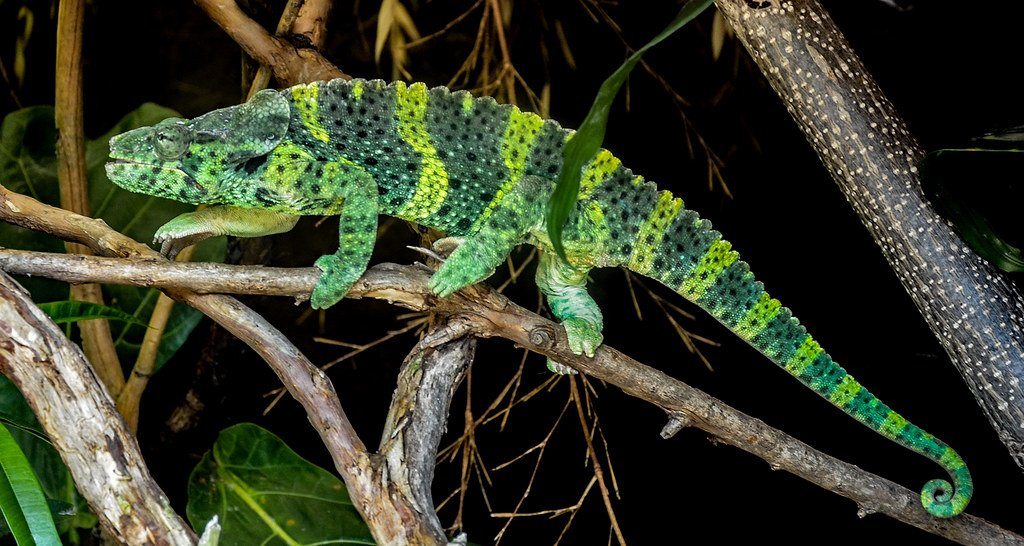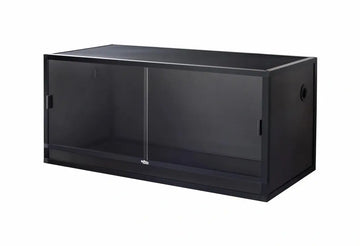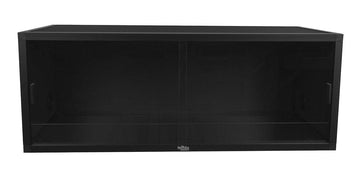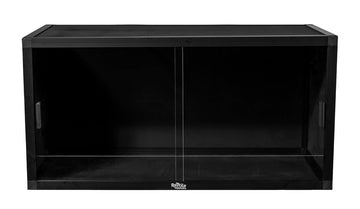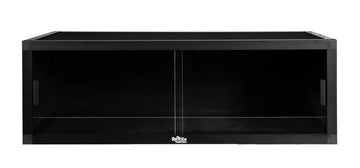The Meller’s chameleon (Trioceros melleri) is a 24” long, diurnal, arboreal lizard native to Tanzania, Mozambique, and Malawi. They can be found in montane forest habitats with cool air, foggy nights, and plenty of rain.
As true chameleons, Meller’s chameleons have bulging, independently-rotating eyes, a long sticky tongue, zygodactylous feet, and a prehensile tail. They can be distinguished by the scalloped crest on their dorsal ridge, rostral horn (missing in some individuals), and bands of bright green and yellow along their body.
Meller’s chameleons are highly sensitive to inadequate husbandry, so they’re not easy animals to keep as pets. They require a lot of space and specialized equipment installed with precision. However, when properly housed, they are capable of living up to 14 years.
Minimum recommended terrarium size for Meller’s chameleons
The minimum recommend enclosure size for a juvenile Meller’s chameleon is 2’L x 2’W x 4’H, but they outgrow this pretty fast. Be prepared to set up a 4’L x 2’W x 4’H enclosure (or larger!) to house your cham as it approaches adulthood.
Meller’s chameleons seem to do well the ventilation and visibility provided by a full-mesh enclosure, but PVC and custom enclosures work fine as well. Be sure to modify them as needed, adding additional screen and/or computer fans as needed.
Housing multiple Meller’s chameleons in the same enclosure is not recommended. Chameleons in general are considered a more advanced reptile, this species in particular is for the more advanced keeper.
Do Meller’s chameleons need UVB?
Yes! Meller’s chameleons require UVB lighting for their survival. UVB lighting helps provide a clear day/night cycle, provides all of the vitamin D that your pet needs, strengthens the immune system, facilitates better digestion, and other benefits.
Here are the best UVB bulbs for Meller’s chameleons:
For best results, house the UVB bulbs in a fixture with a reflector. Place the basking branch so the chameleon’s back will be 6” below the lamp for 6% or 5.0 bulbs, and 12” for 12% or 10.0 bulbs. This is important because the strength of the UVB radiation changes with distance from the bulb.
Meller’s chameleons also benefit from plant grow lights as part of their environment. We recommend a bright ~6500K LED or T5 HO fluorescent grow lamp roughly the same length as the enclosure itself to provide extra illumination, as well as help any live plants in the enclosure to thrive.
Most people do a 12 hours on and 12 hour off lighting schedule. However, you can also do longer times on during the summer and shorter times on in the winter to mimic the actual sun.
Best temperature for Meller’s chameleons
Meller’s chameleons need a basking area temperature around 85°F, and between 70-75°F everywhere else, as measured by digital probe thermometers. Heat lamps should be turned off at night and the temperature allowed to drop by at least 10°F. Evaporative coolers are useful for this purpose.
Provide heat for your chameleon with a cluster of at least two halogen heat bubs placed at least 12” above the basking branch. Halogen bulbs are the best way to imitate the warmth of sunlight indoors, and considered to be a superior form of reptile heating by experts. Do not use ceramic heat emitters (CHEs), red bulbs, or blue bulbs, as these are not as effective.
Best humidity levels for Meller’s chameleons
Meller’s chameleons need moderate to low humidity during the day and high humidity at night for best health. During the day, aim for 30-50% humidity, and aim for 75-100% at night. Humidity should be measured via digital probe hygrometer, with the probe placed in the middle of the terrarium.
Increase humidity by misting the enclosure every morning and night with an automatic misting system. Depending on your chameleon’s needs, you may need to mist in the mid-afternoon as well. Each misting session should last 15-20 minutes. You will also need a cool mist humidifier or evaporative cooler to run at night, connected to a humidistat to maintain humidity levels above 75%.
Reptile humidifiers and foggers should only be used with distilled water and require frequent disinfecting to keep your reptile from getting sick.
Best substrate for Meller’s chameleons
Meller’s chameleons are strictly arboreal, so they don’t really need substrate to dig in or walk on. Plus, because of all the water that goes through the enclosure every day, it easily gets saturated. So, it’s best not to use a substrate with this species.
Instead, use a solid bottom with a drain into a large bucket. This will require some DIY, but is well worth the effort.
How to decorate a Meller’s chameleon terrarium
An empty enclosure makes for a bored and stressed Meller’s chameleon, reducing its quality of life. Keep your pet relaxed and engaged with its environment with the strategic use of decor items that encourage it to exercise natural behaviors!
You will need plenty of vines, branches, and foliage to decorate your terrarium. Arrange them in such a way that the chameleon has somewhere to hide as needed, with an open area under the heat lamp for basking.
All climbing branches should be securely anchored to the walls of the enclosure.
What to feed to a Meller’s chameleon
Meller’s chameleons are insectivores. This means that they only eat insects. Here’s a basic feeding schedule:
- Juveniles — As much as they can eat
- Adults — 1-2 feeders/day
Feeder insect options: crickets, grasshoppers, discoid roaches, dubia roaches, hissing roaches, black soldier flies, hornworms, hornworm moths, silkworms, superworms, darkling beetles, mantids
Make sure to offer a wide variety of insects, not just one or two different kinds!
Supplements
You will also need calcium and vitamin supplements to prevent your chameleon from developing a deficiency. Follow this schedule for supplementing a Meller’s chameleon:
- Every feeding: Arcadia EarthPro A
- Once per month: Repashy Calcium Plus LoD
Skipping a dusting every once in a while is fine. Make sure that all feeder insects are well hydrated and gut-loaded prior to feeding.
How to handle your Meller’s chameleon
Reptiles generally don’t appreciate petting and handling in the same way that dogs and cats do. Some tolerate it more than others, but generally Meller’s chameleons prefer to be left alone. If you want to build a trusting relationship with your pet, you will need to develop a foundation of positive interactions. Offering food from feeding tweezers is a good way to start.
*This care sheet contains only very basic information. Although it’s a good introduction, please further your research with high-quality sources. The more you know, the better you will be able to care for your pet!
"Virginia ZOO in Norfolk - Meller's Chameleon (Trioceros Melleri)" by TDelCoro is licensed under CC BY-SA 2.0

